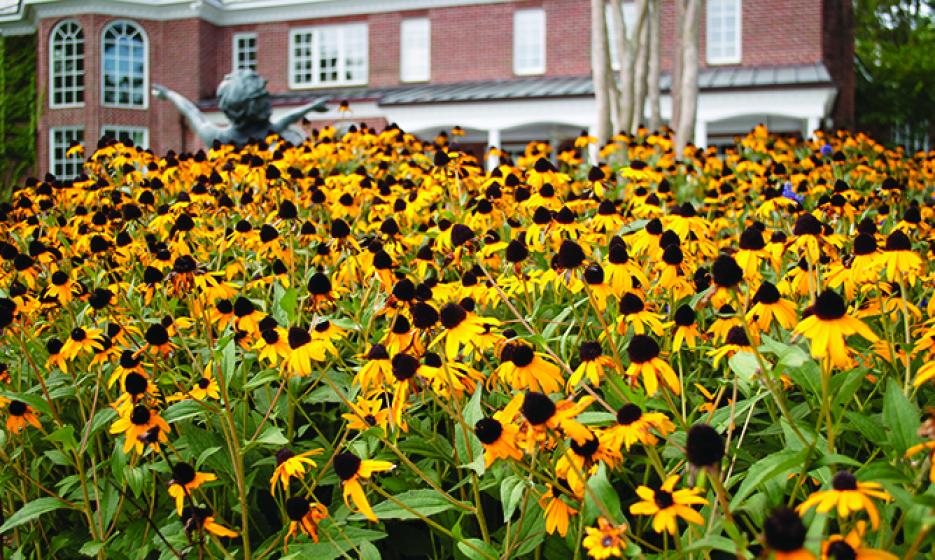Native plant is a term used to describe plants that are indigenous to a particular area. This includes plants that have developed, occur naturally, or existed for many years in a particular place. These plant species are adapted to the soil and weather conditions and are the foundation of our native ecosystems, or natural communities.
WHY LANDSCAPE WITH NATIVE PLANTS?
Native Plants Save Energy:
Native plants have evolved and adapted to local conditions over thousands of years. They are vigorous and hardy, so they can survive winter cold and summer heat. Once established, they require very little care.
Native Plants Provide Balance:
Each native plant species is a member of a community that includes other plants, animals and microorganisms. The natural balance keeps each species in check, allowing it to thrive in conditions where it is suited, but preventing it from running wild.
Native Plants Benefit Local Ecosystems:
Natives are a cornerstone of biological diversity. They provide food and shelter for native wild animals such as birds, butterflies and other wildlife. The also keep the natural balance of each.
Native Plants Help Save the Bay:
Their root systems help rainfall percolate into the soil, reducing erosion and runoff. They help divert water from storm drains and decrease the impact of runoff to rivers and streams and the Chesapeake Bay. This improves water quality.
Here is a recommended list of Natives for you to try in your garden. You will definitely have success with these native plants while benefiting wildlife and our ecosystem.
Native Grass-Like Plants
• Sweet Flag (Acorus gramineus)
• Northern Sea Oats (Chasmanthium latifolium)
• Rush (Juncus effuses)
• Muhly Grass (Muhlenbergia capillaries)
• Switch Grass (Panicum virgatum)
Native Perennials
• Aamsonia (Amsonia tabernaemontana)
• Columbine (Aquilegia Canadensis)
• Swamp Milkweed (Asclepias incarnate)
• Butterfly Weed (Asclepias tuberose)
• False Indigo (Baptisia australis)
• Turtlehead (Chelone glabra)
• Green and Gold (Chrysogonum virginianum)
• Threadleaf Coreopsis (Coreopsis verticillata)
• Fringed Bleeding Heart (Dicentra eximia)
• Coneflower (Echinacea purpurea)
• Joe Pye Weed (Eupatorium coelestinum, dubium)
• Rose Mallow (Hibiscus moscheutos)
• St. John’s Wort (Hypericum calycinum)
• Blue Flag (Iris versicolor)
• Cardinal Flower (Lobelia cardinalis)
• Bee Balm (Monarda didyma)
• Cinnamon Fern (Osmunda cinnamomea)
• Royal Fern (Osmunda regalis)
• Beardtongue (Penstemon digitalis)
• Black-eyed Susan (Rudbeckia fulgida)
• Goldenrod (Solidago sp.)
Native Shrubs
• Serviceberry (Amelanchier canadensis)
• Clethra (Clethra alnifolia)
• Wild Hydrangea (Hydrangea arborescens)
• Inkberry Holly (Ilex glabra)
• Winterberry (Ilex verticillata)
• Yaupon Holly (Ilex vomitoria)
• Sweetspire (Itea virginica)
• Eastern Red Cedar (Juniperus virginiana)
• Bayberry (Myrica cerifera)
• Rugosa Rose (Rosa rugosa)
Native Trees
• Red Swamp Maple (Acer rubrum)
• River Birch (Betula nigra)
• Redbud (Cercis canadensis)
• Fringe Tree (Chionanthus virginica)
• Southern Magnolia (Magnolia grandiflora)
• Sweetby Magnolia (Magnolia virginiana)
• Willow Oak (Quercus phellos)
• Live Oak (Quercus virginiana)
• Bald Cypress (Taxodium distichum)
Native Vines
• Crossvine (Bignonia capreolata)
• Carolina Jasmine (Gelsemium sempervirens)
• American Wisteria (Wisteria frutescens)

